 The GMES services for Security applications aim at supporting the related European Union policies in the following priority areas:
The GMES services for Security applications aim at supporting the related European Union policies in the following priority areas:
- Border surveillance
- Maritime surveillance
- Support to EU External Action.
In the area of border surveillance, main objectives are to reduce the number of illegal immigrants entering the EU undetected, to reduce the death toll of illegal immigrants by rescuing more lives at sea and to increase internal security of the European Union as a whole by contributing to the prevention of cross-border crime. For instance, GMES services are expected to contribute to the implementation of EUROSUR, the European Border Surveillance System, by supporting the mapping and monitoring of border areas.
Concerning maritime surveillance, the overall objective of the European Union is to ensure the safe use of the sea and to secure Europe’s maritime borders. The corresponding challenges mainly relate to safety of navigation, marine pollution, law enforcement, and overall security.
As a global actor, Europe has a responsibility in promoting stable conditions for human and economic development, human rights, democracy and fundamental freedoms. In this context, a main objective of the EU is to assist third countries in a situation of crisis or emerging crisis and to prevent global and transregional threats having a destabilising effect (e.g. proliferation of weapons of massive destruction). GMES have a strong potential to support EU External Action through the detection and monitoring of security threats. It can also contribute towards improving crisis prevention, preparedness and response capacities.
Pre-operational versions of GMES security services addressing border surveillance and support to EU External Action are currently provided through the EU-funded project G-MOSAIC.
G-MOSAIC provides Intelligence and Early Warning services that contribute to the analysis of the causes leading to regional crises, such as weapons proliferation, fighting for natural resources, population pressure, land degradation, and illegal activities. Crisis indicators are also developed. Intelligence and Early Warning services address four security domains:
- Natural Resources and Conflicts;
- Migration and Border Monitoring;
- Nuclear and Treaties Monitoring;
- Critical Assets.
G-MOSAIC also provides services that contribute to support the planning for EU intervention during crises, EU intervention and citizen repatriation during crises, crisis consequences management, reconstruction & resilience. The corresponding services belong to a fifth security domain:
- Crisis Management and Assessment.
A more detailed description of the current security service as developed by G-MOSAIC is available in a Service/Product Portfolio specification.
Natural Resources and Conflicts (NRC)
The service consists of crisis indicators aimed at improving current alert systems. These indicators specifically address the relations between security issues and all the possible „conflict factors“ in regional crises.
The service includes the following service chains:
- Exploitation of natural resources (ENR);
- Population pressure (POP);
- Land degradation (LND).
The service also aims at monitoring illegal activities in order to detect new regions of activities and the correlations and consequences to the vicinity.
The service includes the following service chains:
- Illegal mining (ILM);
- Illegal timber logging (ILL);
- Illicit crops (ILC).
Migration and Border Monitoring (MBM)
The service addresses the theme of migrations with an integrated approach, including origin and destination countries, long range routes and characterisation of the population movements (refugees, terrorist or militia movements, or activities involving smuggling militarily significant payloads, cargos or weaponry). Special attention is paid to border crossing activities and military activities in areas adjacent to borders.
The service includes the following service chains:
- Border area monitoring (BAM);
- Monitoring of settlements (MRS).
Nuclear and Treaties Monitoring (NTM)
The service addresses the monitoring of nuclear facilities and other treaty related infrastructures. They include regular assessment, identification and monitoring of nuclear capabilities and infrastructures, decommissioning sites. Other essential requirements such as weapons delivery systems and related defence infrastructures could be covered.
The service includes the following service chains:
- Monitoring of nuclear decommissioning sites (MND);
- Continuous surveillance of nuclear facilities (SNF).
Critical Assets (CTA)
The service addresses the monitoring of critical assets and the detection of changes. Critical Assets comprise a wide variety of elements, either manmade structures (e.g. energy pipelines, industrial sites) or natural assets (e.g. fresh water points), whose disruption, destruction or alteration may cause problems for the security of the States and citizens.
The service includes the following service chains:
- Critical assets monitoring (CAM);
- Critical assets event assessment (CAE).
Crisis Management and Assessment (CRI)
The service addresses the different phases of a crisis:
- Planning and preparedness, through the provision of geo-spatial information to support crisis prevention and intervention (e.g. city maps). The service is designed for a situation of forthcoming crisis, addressing areas in which there is a need for imminent action;
- Crisis response, through the provision of information oriented towards rapid response. The service delivers layers of information on transportation networks, logistics facilities (e.g. hospitals), critical assets and infrastructure (e.g. airports/airfields), helicopter landing areas and population gathering areas;
- Post-conflict damage assessment and reconstruction, in order to improve the rehabilitation process, notably through the provision of change detection products.
The service includes the following service chains:
- Contingency plan preparation (CPP);
- Rapid geospatial reporting (RGR);
- Damage assessment for post-conflict situations (DAP);
- Support to reconstruction missions after conflicts (SRM).
Source: http://www.gmes.info/pages-principales/services/security/
